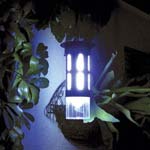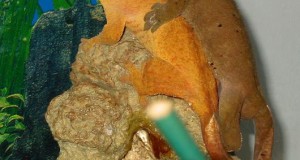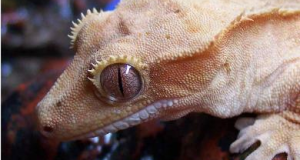What DO Leopard Geckos Eat?! The Leopard Gecko, Eublepharis macularius, makes a wonderful pet for novices and advanced hobbyists alike (even after many years as a professional zookeeper, I enjoy keeping them, and wrote a book about their care). However, both sellers and buyers sometimes underestimate this delightful lizard’s needs, especially where feeding is concerned. Contrary to popular belief, vitamin-powdered crickets and mealworms do not constitute a suitable diet! If you wish your pet to live out its potential lifespan of 20-30 years in excellent health, you’ll need to provide it with as many different foods as possible. Fortunately, a surprising array of insects can be purchased online and in stores. Collecting and rearing your own insects is another excellent way to add to your gecko’s quality of life…and its great fun as well!
Wild Leopard Gecko Diets
As with any species, we can learn much about our pets’ captive needs by examining the natural diet. Leopard Geckos are denizens of dry, rocky scrublands ranging from northwestern India to Iraq, and feast upon a wide array of invertebrates. Several species of spider, beetle, locust, caterpillar, scorpion, fly and others have been documented as prey items. Small lizards, snakes, and newborn rodents such as gerbils are taken on rare occasions.
Insects That You Can Buy
Note: It’s important to allow “feeders” to consume a healthy diet for several days before offering them to your lizards. I’ve written articles on most of the species listed here; please see the links below and post any questions you may have.
For the lizards under my care in zoos and at home, I generally rely upon commercial species during the winter, and switch wild insects in the spring. While crickets can be used as an important part of your pet’s diet, you should also include as many of the following as possible:
Orange-Spotted and other Roaches
Sow or Potato Bugs (terrestrial crustaceans)
Butter Worms (moth caterpillars from Chile)
Calci or Phoenix Worms (Black Soldier Fly larvae)
Silkworms
Tomato Hornworms
Small Locusts (not sold in the USA)
Small crayfishes (which can be purchased or collected) are a great high-calcium food accepted by many lizards. Although wild Leopard Geckos regularly tackle scorpions, to be on the safe side, I remove crayfish claws.
I use mealworms and super mealworms sparingly and usually select only newly-molted (white) grubs.
Mice
A pink mouse offered every 4-6 weeks will do no harm, especially for females that are being prepared for breeding, but over-use may cause eye, kidney and liver ailments. At the Bronx Zoo, we documented this most clearly in Green Basilisks and other reptiles that have evolved to subsist upon a diet comprised mainly of invertebrates. Do not feed “fuzzy” or larger mice to Leopard Geckos, as the fur may cause intestinal impactions.
Canned Insects
Leopard Geckos usually take readily to tong-feeding. Canned Grasshoppers and Silkworms offer a convenient means of adding variety to your lizard’s diet.
Wild Caught Insects
As my regular readers are, no doubt, tired of hearing (sorry!) I always encourage lizard keepers to consider collecting their own live foods. Some exciting successes that I and colleagues have had can be credited in part to the use of wild-caught insects. Caution concerning pesticides and toxic species is necessary; please see the linked articles and post any questions below.
I’ve found the following insects to be especially favored by Leopard Geckos and other insectivorous lizards:
Moths
May Beetles (and many others)
Beetle Grubs
Caterpillars (avoid hairy and brightly-colored species)
Sow Bugs
Tree, Camel and Field Crickets
Katydids
Harvestman (“Daddy Longlegs”)
Small Praying Mantids
Bee Flies
Crane Flies
Grasshoppers and Locusts (avoid Lubbers and other colorful species)
There’s an infinite variety of other possibilities…please post your own experiences below.
 Insect Traps and Collecting Techniques
Insect Traps and Collecting Techniques
As you begin paying more attention to wild species, don’t be surprised if you wind up with invertebrate-keeping as a whole new hobby! I’m always adding new native species to my collection…this summer I focused on Fishing Spiders, Crab Spiders and Giant Water Bugs.
The Zoo Med Bug Napper is a scaled-down version of the traps I employed at the Bronx Zoo. It effectively snares moths, beetles, and other flying insects.
I use many techniques to provide my geckos with nutritious foods. Some favorites are bush-beating, pitfall traps, termite traps, leaf litter collection and sweeping through tall grass with a net.
Hatchlings and Smaller Leopard Geckos
Nutritional variety is especially important to growing lizards.
In addition to smaller individuals and species of the insects mentioned above, try large midges (the Zoo Med Bug Napper works well for these), sap beetles, newly-hatched mantids, flour beetle larvae, ants (some species are rejected; others bite or sting), aphids (tiny green/red insects that colonize plant stems) and “field plankton” (insects gathered by sweeping through tall grass with a net).
Supplements
I powder captive-reared insects with ReptiVite and ReptiCalcium. I do not use supplements on wild-caught invertebrates. Supplement use should be tailored to the individual lizard…please post below for further information.
How Much and How Often?
Good news – Leopard Geckos evolved in harsh environments where food availability varies widely throughout the year. Therefore, they store food very effectively, and can tolerate (reasonable!) experimentation. Obesity is generally more of a concern than starvation. Healthy, non-breeding adults kept at proper temperatures do well on 7-10 average-sized (approximately ½ the width and ¾ the length of your gecko’s head) insects weekly.
Your pet’s food can be divided into 3 weekly meals or more frequent, smaller offerings. Newly-hatched geckos can be fed daily, with meals decreased to every other day or so as they reach 1 year of age.
Further Reading
 That Reptile Blog – Reptile, Amphibian and Exotic Pet Care and Information
That Reptile Blog – Reptile, Amphibian and Exotic Pet Care and Information







Very Informative post. Provided the information i was looking for to take care of my pet.
Thanks!
Much appreciated! Best, Frank
We have one leopard gecko- probably about 2 years old. Our neighbors took down a bees nest from a tree and now the larva are all over the ground. Can we feed these to our gecko? They are going to die anyway.
Thx
I.S.
Hello,
I’ve not tried, but larvae contain no protective toxins and so should be safe to use…start slowly, however. You may be able to store in frig. Best, Frank